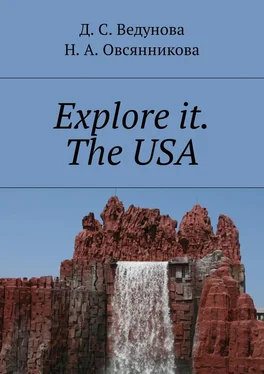Н. Овсянникова - Explore it. The USA
Здесь есть возможность читать онлайн «Н. Овсянникова - Explore it. The USA» — ознакомительный отрывок электронной книги совершенно бесплатно, а после прочтения отрывка купить полную версию. В некоторых случаях можно слушать аудио, скачать через торрент в формате fb2 и присутствует краткое содержание. ISBN: , Жанр: Языкознание, Путешествия и география, на английском языке. Описание произведения, (предисловие) а так же отзывы посетителей доступны на портале библиотеки ЛибКат.
- Название:Explore it. The USA
- Автор:
- Жанр:
- Год:неизвестен
- ISBN:9785449007407
- Рейтинг книги:4 / 5. Голосов: 1
-
Избранное:Добавить в избранное
- Отзывы:
-
Ваша оценка:
- 80
- 1
- 2
- 3
- 4
- 5
Explore it. The USA: краткое содержание, описание и аннотация
Предлагаем к чтению аннотацию, описание, краткое содержание или предисловие (зависит от того, что написал сам автор книги «Explore it. The USA»). Если вы не нашли необходимую информацию о книге — напишите в комментариях, мы постараемся отыскать её.
Explore it. The USA — читать онлайн ознакомительный отрывок
Ниже представлен текст книги, разбитый по страницам. Система сохранения места последней прочитанной страницы, позволяет с удобством читать онлайн бесплатно книгу «Explore it. The USA», без необходимости каждый раз заново искать на чём Вы остановились. Поставьте закладку, и сможете в любой момент перейти на страницу, на которой закончили чтение.
Интервал:
Закладка:
The Northern Rocky Mountains (north of 45° N) are mainly composed of granites up to 3954 m in height (Robson Mountain); The southern Rocky Mountains, or the Rocky Mountains of the United States, consist of short ridges composed of sandstones, shales, limestones, up to 4,401 m (Albert Mountain – the highest point of the Rocky Mountains). There are extensive deposits of molybdenum, copper, gold, silver, polymetals, oil, and coal. Volcanic phenomena are observed: geysers, thermal springs, and earthquakes.
In the Rockies is a typical mountain climate. The average annual temperature in the valleys is within 6° C. In July, the warmest month, the average temperature reaches 28° C. In January, the average temperature is about -14° C, and this is the coldest month of the year. The average annual precipitation is about 360 mm.
In the Rocky Mountains in the summer it is usually warm and dry, as rain clouds from the west linger on the mountain ridge on its western side. The average temperature in summer is 15° C, and the average amount of precipitation is about 150 mm. Winters are very long and cold, with an average temperature of -2° C, and an average thickness of snow cover of 29 cm. In the spring, the average temperature is 4° C, and the precipitation is 107 mm. In autumn, the average rainfall is 66 mm and the temperature is about 7° C.
Vegetation – mainly forests, mountain-taiga in the north and pine in the south. The height of the forest boundary is from 1500 m (in the north) to 3600 m (in the south), higher – alpine meadows and eternal snow.
In the forests grow spruce, pine and fir, on the lower tiers, they mix with birches and white maple. Most of the mountains of the Arctic latitudes are covered with dwarf birches. On taiga soil not only coniferous, but also deciduous trees grow: birch, poplar and aspen.
In the valleys there are steppes and semi-deserts.
High-altitude animals here are snow goats, thick-nosed, elks and foxes. In the areas below, there is a marmot, a hare-hare, a black-tailed meadow dog and a coyote.
Most of the birds living in the Rocky Mountains are flying. In the summer months they feed the chicks here. Constantly in the mountains there live a three-toed woodpecker, a white partridge, some species of finches and owls.
In the Rockies are national parks Jasper (Canada), Banff (Canada), Yoho (Canada), Kootenay (Canada), Waterton Lakes (Canada), Glacier (USA), Yellowstone (USA), Rocky Mountain (USA).
Great Plains.
Great Plains – a piedmont plateau in the US and Canada, east of the Rocky Mountains. The height is about 700—1800 m above sea level. The length is about 3600 km, the width is from 500 to 800 km.
On the Great Plains are the territories of the Canadian provinces of Alberta, Manitoba and Saskatchewan and the American states of New Mexico, Texas, Oklahoma, Colorado, Kansas, Nebraska, Wyoming, Montana, North Dakota and South Dakota.
Great plains from north to south are divided into such major zones as the Missouri Plateau, the central High Plains, the Llano Estacado Plateau and Edwards. In some areas erosion of rocks is observed (these are the so-called bad lands, «badlands»). In the south they pass to the Mexican Highlands.
The climate within the plains is continental. Vegetation is mostly steppe.
On the plateau territory, wheat production is developed (the Great Plains are often called the «World Bread-Bread»), pasture cattle breeding. The US began to develop this area after the Louisiana purchase (1803). As early as 1820, researchers recognized these lands as unsuitable for life.
The Great Lakes
The Great Lakes (Grands Lacs, sometimes also the Great Laurentian lakes) are a system of freshwater lakes in North America, in the United States and Canada (Lake Michigan is entirely in the USA, the rest of the lakes and the short rivers that connect them cross the border between the USA (⅔ the water area) and Canada (⅓ the water area of lakes)). Includes a number of large and medium-sized reservoirs, connected by rivers and straits. The five largest ones are the Great Lakes themselves: Upper, Huron, Michigan, Erie and Ontario, although they sometimes include the St. Claire Lake, they form the largest group of freshwater lakes on Earth (a total area of 244,106 km², a total of 22,671 km³)), containing 21% of the surface in the world of fresh water (and 84% of freshwater in North America). Several middle lakes are associated with them, the most important of which are: St. Marys, Manitou, Nipigon, Nipissing. Lakes belong to the basin of the Atlantic Ocean, drain on the St. Lawrence River.
The formation of lake basins is most affected by tectonic processes; Great lakes began to form at the end of the last glacial period, about 10,000 years ago, when the mass of the glacier crushed the earth’s crust, and after the glacier melt, a slow reverse process began, glacioisostasis, which is also very noticeable in the Gulf of Bothnia and Finland. The water mass of the lakes was formed during the melting of the glacier. The northern coast of the Great Lakes rises faster than the southern one, which leads to the effect of «transfusion» of water and the slow flooding of lands in the south. Earlier, the Great Lakes had an additional runoff through the current rivers Illinois and Ottawa, but due to all the same geological processes, they, even today, near the shores of the lakes, changed their course somewhat and radically changed the source. As a result, today the natural runoff exists only along the St. Lawrence River.
With the help of canals, a waterway has been formed for sea ships with a length of about 3,000 km. Great lakes are connected by canals with the Hudson River and the Mississippi River basin.
Great lakes are among the largest on Earth accumulations of fresh water. Only Baikal and the glaciers of Greenland and Antarctica can compete with them. They are interconnected by rivers and canals, and therefore water flows from one to the other. The upper lake is the largest freshwater lake in the world, and Ontario alone is larger than the largest lake in Europe, Ladoga. Their average depth, not being very large, exceeds the average depth of the Baltic and North Seas.
The length of the coastline (with islands) is about 18 thousand km. The total area is 244,106 km², the basin area is 768,000 km² (including the area of the lakes themselves), the total volume of 22,671 km³, the four lakes of depth exceed 200 m and only Erie Lake has the greatest depth of 64 m, and St. Clare only 8. The largest and deepest of the Great Lakes is Lake Superior, the smallest – Lake St. Clair.
Several hundred small rivers flow into the Great Lakes, the flow from the lakes occurs along the St. Lawrence River, flowing from Lake Ontario and flowing into the Atlantic Ocean; the average water discharge at its source is 6637 m³ / s.
Previously, sewage, paper and other factories were discharged into these lakes. At first, the Erie Lake was significantly polluted, it was silt, many kinds of commercial fish disappeared from it. The government allocated significant funds for cleaning the lakes. Now the lakes are relatively clean. Great lakes are very important objects of rest and navigation.
The climate of the Great Lakes is humid, temperate, similar to the climate of the Middle Baltic. The area of the Great Lakes is characterized by sharp changes in weather conditions. This is due to the proximity of such different regions as the cold Hudson Bay in the north and the very warm Mexican Gulf in the south. The most variable season is winter, it is snowy, active cyclones are observed. Cyclones are also associated with frequent intrusions of Arctic air at this time, leading to a sharp cooling, and sometimes in a matter of hours frozen important areas for navigation. In winter, ice first covers Lake Superior, then – Huron and Michigan, lastly – Erie. The lakes are not frozen completely, but navigation stops, becoming impossible from December to April. Spring lasts a long time, often freezing. The summer is cool, it is, like winter, changeable, with frequent rains and a strong wind. Autumn includes a period of up to two weeks, called «Indian summer» with clear and dry weather. Autumn is considered the best season in the Great Lakes region.
Читать дальшеИнтервал:
Закладка:
Похожие книги на «Explore it. The USA»
Представляем Вашему вниманию похожие книги на «Explore it. The USA» списком для выбора. Мы отобрали схожую по названию и смыслу литературу в надежде предоставить читателям больше вариантов отыскать новые, интересные, ещё непрочитанные произведения.
Обсуждение, отзывы о книге «Explore it. The USA» и просто собственные мнения читателей. Оставьте ваши комментарии, напишите, что Вы думаете о произведении, его смысле или главных героях. Укажите что конкретно понравилось, а что нет, и почему Вы так считаете.












